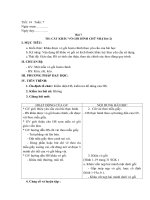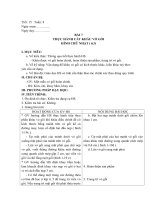BAI 7 LOP11READ HOT
Bạn đang xem bản rút gọn của tài liệu. Xem và tải ngay bản đầy đủ của tài liệu tại đây (887.03 KB, 35 trang )
<span class='text_page_counter'>(1)</span>
<span class='text_page_counter'>(2)</span> * Change this direct speech into reported speech. Peter said “ I’m sorry I’m late” ( apologise) Peter apologised for being late..
<span class='text_page_counter'>(3)</span> WARM-UP. 10. 1. 9 6. 2. 8. 3 5. 7. 4. How many children are there in the picture ?.
<span class='text_page_counter'>(4)</span> Water pollution.
<span class='text_page_counter'>(5)</span> Traffic jam.
<span class='text_page_counter'>(6)</span> Shortage of water.
<span class='text_page_counter'>(7)</span> The earth (Trái đất). They tell us that we are facing overpopulation.
<span class='text_page_counter'>(8)</span> UNIT 7: WORLD POPULATION A. READING.
<span class='text_page_counter'>(9)</span> UNIT 7: WORLD POPULATION - READING. OUTLINE I. WARM-UP II. PRE-READING VOCABULARY. III.WHILE-READING 1. TASK 1 2.TASK 2 IV. POST-READING.
<span class='text_page_counter'>(10)</span> UNIT 7: WORLD POPULATION - READING. PRE- READING.
<span class='text_page_counter'>(11)</span> UNIT 7: WORLD POPULATION - READING. NEW VOCABULARY.
<span class='text_page_counter'>(12)</span> UNIT 7: WORLD POPULATION - READING. to increase: Gia tăng. ≠ to decrease: giảm.
<span class='text_page_counter'>(13)</span> UNIT 7: WORLD POPULATION - READING. - family planning (n.ph) : kế hoạch hóa gia đình.
<span class='text_page_counter'>(14)</span> UNIT 7: WORLD POPULATION - READING. - to raise animals: nuôi động vật - to double:. gấp đôi. 20 40. - B.C. (prep. phr.): (Before Christ) trước Công Nguyên ≠ A.D. (Anno Domini) - figure (n): - resource (n):. con số. 625 , 2510, 35. nguồn tài nguyên. - Third World (n.ph) :. Coal, oil ,... Thế Giới Thứ 3.
<span class='text_page_counter'>(15)</span> UNIT 7: WORLD POPULATION - READING. to increase: tăng to decrease : giảm nuôi động vật to raise animals : to double: gaáp ñoâi Third World (n.phr.):thế giới thứ ba family planning (n.phr.) : kế hoạch hóa gia đình figure (n) : con số resource (n) : nguồn tài nguyên B.C.: Before Christ (n.phr.): trước Công Nguyên.
<span class='text_page_counter'>(16)</span> UNIT 7: WORLD POPULATION - READING. to increase: tăng to decrease : giảm nuôi động vật to raise animals : to double: gaáp ñoâi Third World (n.phr.):thế giới thứ ba family planning (n.phr.) : kế hoạch hóa gia đình figure (n) : con số resource (n) : nguồn tài nguyên B.C.: Before Christ (n.phr.): trước Công Nguyên.
<span class='text_page_counter'>(17)</span> UNIT 7: WORLD POPULATION - READING. WHILE - READING.
<span class='text_page_counter'>(18)</span> UNIT 7: WORLD POPULATION - READING. TASK 1: The words in the box all appear in the passage . Fill each blank with a suitable word. (Change the form of the word and use the dictionary when necessary).
<span class='text_page_counter'>(19)</span> UNIT 7: WORLD POPULATION - READING. limit. control. international method. resources. 1.Can you explain the_____ for changing salt water to fresh water? 2.Some countries are poor because they have very few natural____ 3. There is a(n)_______of 20 minutes for this short test. Students must turn in their papers at the end of 20th minute. 4. The United Nations is a(n)_____________ organisation.. 5. Some children behave badly and their parents can’t_____them..
<span class='text_page_counter'>(20)</span> UNIT 7: WORLD POPULATION - READING. TASK 2.TRUE / FALSE STATEMENT. T The world population has been increasing faster 1. .......... and faster. F People predict that the world 2. ............ population will increase over 10 7 billions by 2015. F Our resources are unlimited 3. ............. limited. F Only 10 4. ............ 20 % of the earth’s land can be used for farming and another 20 10 % of the earth’s land can be used for raising animals. T The international organizations 5. ............ have been trying to do something to decrease the population of the world.. . . . .
<span class='text_page_counter'>(21)</span> UNIT 7: WORLD POPULATION - READING. POST - READING.
<span class='text_page_counter'>(22)</span> UNIT 7: WORLD POPULATION - READING. LUCKY APPLES. win.
<span class='text_page_counter'>(23)</span> UNIT 7: WORLD POPULATION - READING. Choose the correct item to complete the sentence: According to the passage, only _________of the earth’s land can be used for farming. A. 20 percent B. 8 percent C. 10 percent D. 30 percent.
<span class='text_page_counter'>(24)</span> UNIT 7: WORLD POPULATION - READING. LUCKY ALLPE.
<span class='text_page_counter'>(25)</span> UNIT 7: WORLD POPULATION - READING. What resources are limited? A. Petroleum and silver. B. Iron and gold. C. Water D. All are correct..
<span class='text_page_counter'>(26)</span> UNIT 7: WORLD POPULATION - READING. Why can’t women in the world limit the size of their family?. A. Because they know of no safe way to have fewer children. B. Because they want to have a lot of children. C. Because it depends on their husbands D. All are correct.
<span class='text_page_counter'>(27)</span> UNIT 7: WORLD POPULATION - READING. Choose the best option: Most of Third World women ____ to have many children. a.wish b. try c. refuse d. don’t want.
<span class='text_page_counter'>(28)</span> UNIT 7: WORLD POPULATION - READING. Choose the best option: In _____ the world’s population was 4,760 million people.. a. 1985 b. 2000 c. 2015 d. 1850.
<span class='text_page_counter'>(29)</span> The population of the world has been increasing faster and faster . In 10,000 BC., there were probably only 10 million people. In A.D. 1, there were 300 million. It took 1,750 years for the world population to reach 625 million. In 1850, only 100 years later, the population reach the figure of 1,300 million. In 1950, the figure had more than doubled to reach 2,510 million. In 1985, only 35 years later, there were 4,760 million people. In 2000, the world’s population was about 6,6 billion, and by 2015 it is expected to be over 7 billion ..
<span class='text_page_counter'>(30)</span> Does the earth have enough resources to support this many people? Different scientists give different answers to this question. Some say that there are enough resources to support 8 billion people. Other say that we must limit population growth because our resources are limited. Only 10 percent of the earth’s land can be us ed for farming and another 20 percent for rai sing animals . There is a limit to the water we can use. There are also limits to the amounts of petroleum, iron, silver, gold, and other metals..
<span class='text_page_counter'>(31)</span> Research has show that the average Third World woman has more children than she wants. Among the women who do not think they have too many children, half of them do not want any more. However, although millions of women want to limit the size of their families, they know of no safe way to have fewer children. Safe birth – control methods for family planning are not available to them. It is time governments and international organi zations did something to help them so that the world population growth can to decrease instead of continuing to increase.
<span class='text_page_counter'>(32)</span>
<span class='text_page_counter'>(33)</span> UNIT 7: WORLD POPULATION - READING. Consolidation MATCH. Paragraph: • Paragraph 1 • Paragraph 2. • Paragraph 3. Main ideas: A. The reason for population growth B.The figures of population growth through years C.Resources and population growth.
<span class='text_page_counter'>(34)</span> HOMEWORK : -LIST FIVE WORLD LARGEST COUNTRIES IN POPULATION - LEARN BY HEART THE NEW WORDS - PREPARE SPEAKING PART.
<span class='text_page_counter'>(35)</span>
<span class='text_page_counter'>(36)</span>









